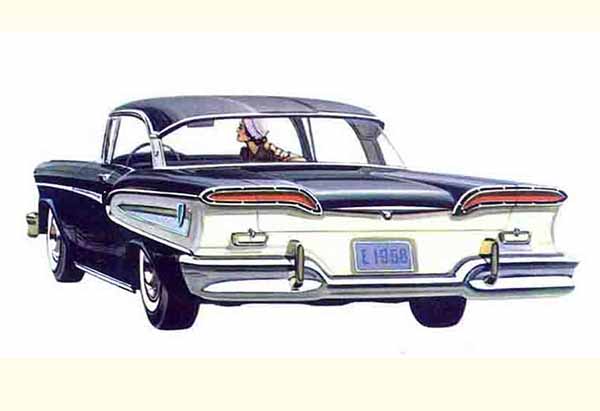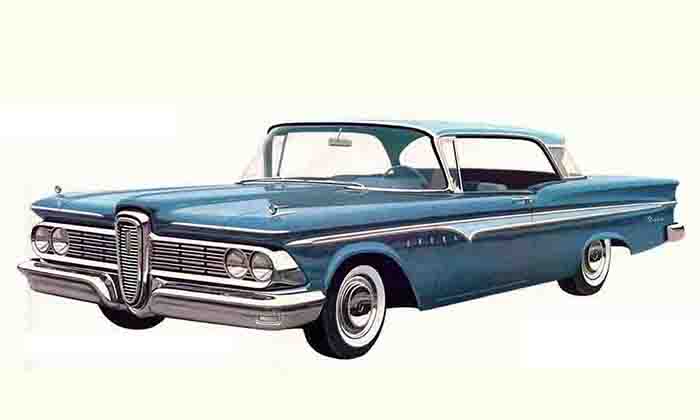
The Edsel Story: Bad Decisions Kill a Good Car
1958-1960
We tend to think that the US auto industry has been guilty of bonehead decisions only in the last 30 years, but that is not the case. We also tend to think that the Big Three were only disconnected from their customer base in the period 1978-1988, but this is not true. The industry has been making bad decisions from the beginning, resulting in many flops or failed companies.
However, the most blatant example still stands out – the Edsel. Funny thing is, the Edsel was not a bad car, was not a poorly designed vehicle, and its build quality was no worse than its contemporaries. Edsel’s mistake was simply being introduced at the wrong time.
First, we need to set the stage for the car, and why it came to exist at all. Conceived in the mid-fifties during the heyday of health in the industry, when every make was selling, the Edsel concept was, for Ford, a good idea at the time.
Ford had surveyed the market in 1954-55 and learned that their vehicle spread vs. GM was deficient. Lincoln was not competing with Cadillac, but rather with Buick. Mercury was competing with Pontiac leaving Oldsmobile free to sell like crazy. Ford Decided to move both Mercury and Lincoln upstream and to fill the gap with a car that could go head to head with Pontiac and Olds, with Mercury facing Buick and Lincoln paired versus Caddy.
Thus, the Edsel idea was born. The new car would span the Pontiac brand, which was studied extensively, and nudge into Oldsmobile’s low-end turf. In preparation for this foray, in 1956, Lincoln offered more luxury, including the Continental II and in 1957 Mercury got the Turnpike Cruiser, falling into the old Lincoln base Capri spot.
Meanwhile, big changes were planned for 1958. Ford would remain little changed, but the new car, now called “Edsel” would be slotted in between the Fairlane 500 and Medalist (a new entry Mercury), overlapping both the top-end Ford and the bottom Mercurys, in both size and price. Mercury would get a more upscale Parklane model, closing the gap between it and Lincoln.
When all was said and done, it looked good. Now FoMoCo had a better spread between the bottom of the market and the top, with more models and brands for buyers to choose from. Things looked so good on paper (200,000 Edsels were projected to be sold for the year 1958) that a whole new Division (Edsel) and dealer network was set up. The only thing that The corporation did that turned out to be wise, is that the cars were not made in separate facilities, merely “contracted” for certain plants already dedicated to Ford and Mercury assembly plants.
But sometimes you drink your own Kool-Aid. In their zeal to sell the idea to corporate and to the proposed dealers, marketing exaggerated their own claims, and even the market size and penetration. Worse, it took them three years (the normal model cycle) to get the proposed car to market. In that time three things happened: 1) The country hit a recession; 2) Larger cars were starting to wear on the public; and 3) Ford and Mercury moved into the space Edsel would occupy. The latter was allowed by Corporate to placate the dealers who saw sales being eaten into by the new brand – exacerbated by the idea that there would be a new dealer network. This could have been alleviated by having the cars sold through the Ford dealer network ala Lincoln-Mercury, but the dealer franchises were already sold.
By the time the Edsel came to market, there was no place for it. Worse, Edsel touted their highest-priced Citation in all their early ads, giving people the idea it was a super Mercury, rather than a mid-price car. When it hit in 1958, car sales were slumping everywhere, and the perception was that the car was beyond most of the projected buyers.
Also, there were four lines of cars; Ranger, Pacer, Corsair, and Citation, where really only the Pacer and Citation were needed. Buyers were offered too many choices in a line that was just starting out. As a result, Edsel sold only 60,245 cars. This was the best brand launch since Plymouth in 1933, but it was still not enough.
When the Corporation realized its mistake, the exacerbated the problem by moving the Edsel downstream in 1959, with only the Ranger and Corsair offered. But by this time Ford had released their new Galaxie right into the space where Edsel Corsair would sit, and the Ranger was really a low-end Fairlane 500, in both features and price. Instead of moving upstream, where larger cars were still selling, Edsel moved right into the most competitive part of the marketplace. The best Edsel could muster was 44,889 sales at a time when Olds and Pontiac, their original target, doubled their 1958 sales.
By that time, most Edsel dealers had either folded or been absorbed into the Ford camp, with a few going upstream to Mercury. Thus, Edsel made the final and fatal mistake, releasing the 1960 car as practically a Ford clone. It was the white flag of the surrender, and surrender they did, selling only 2,846 cars in total.

The Edsel was a dramatic-looking car back in 1958

The rear 3/4 view was also interesting – think 1959 Chevy and Pontiac styling cues.

The ’59 version split the difference, still trying to emphasize the verticle grille while not looking as dramatic. This look is similar to the Pontiac GP of later years

The 1960 version was a warmed-over Ford, but they did make an attempt to differentiate.

Was it a bad car?
Actually, it was a good car. It introduced some new and good features and offered solid mechanical components and proven engineering. Some of its features would be adopted by others in a few years, such as key locking the trans in the park and self-adjusting brakes.
Was its styling off-putting?
No, not at the time. In 1958 it was actually considered a good styling exercise, though the grille did get some criticism. The strident attack on it did not come until later years when it was used as an excuse for poor sales. The grille’s look was copied by the Pontiac Grand Prix in the 70s. Ford copied much of the ’58 Edsel styling for its ’59 model, which sold almost 1.5 million copies, as well as rival Chevrolet.
Was it over-priced?
No, it was priced appropriately in 1958. The problem was it had a split personality – it was both a low-priced car and a mid-priced car AND a high-priced car. In 1958, the car’s audience had no idea where it fits in the market, hence they could never attract the right buyers. In ’59, it moved down the market and directly competed with Ford for buyers – totally against what the car was designed to do.
Could it have been a success?
Frankly, it was just in the wrong place at the wrong time. Had it been introduced in the mid-fifties or the mid-sixties, it could have survived. Second, it should never have had a separate dealer network. The cost and confusion of a separate line at a time when the market was contracting was a huge mistake. Last, Edsel and FoMoCo could not decide what to tell the public about the car’s placement in the market.
What stands out now was that wherever there should have been a definitive decision on something, there was a compromise:
- Too many models spanning too much of the market;
- A separate dealer network;
- Allowing Ford and Mercury to have models in the space to be occupied by Edsel; and
- A scattered marketing message
All those bad decisions are what killed the Edsel.











